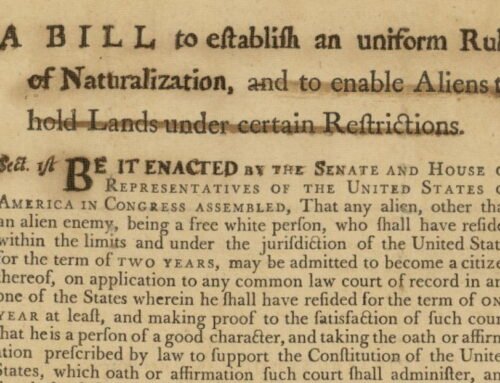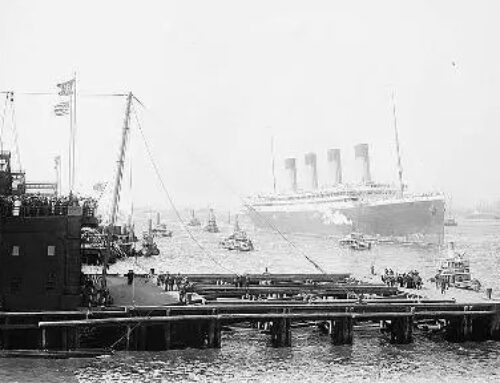Have you discovered immigrant ancestors detained at Ellis Island? Between 1880-1920, more than 20 million immigrants arrived at Ellis Island. The inspections they endured are well documented. But what happened to those detained at Ellis Island?
Ancestors Detained at Ellis Island
About 2 percent of immigrants were detained at Ellis Island for Special Inquiry (SI). Detained individuals then faced an extended interview with inspectors and medical staff. About one percent were classified and detained for political or legal reasons, including suspected criminals and anarchists.
Detained for Medical or Legal Reasons
About one percent were detained if suspected of a “loath-some or a dangerous contagious disease.” Immigrants with curable diseases were sent to medical facilities on Ellis Island. In other cases, hospitals in Manhattan received immigrants who were ill.
Suspected contagious cases were sent to Swinburne Island for observation. Active contagious cases were quarantined on Hoffman Island. Those diagnosed as incurable were deported. The steamship company was responsible for the return fare, according to U.S. legislation. However, ticket contracts were often written to place the burden on the passenger.
Liable to Become a Public Charge (LPCs)
After the Immigration Act of 1882 was passed, special emphasis was placed on LPCs, or “those liable to become a public charge [to taxpayers]. ”The LPC classification was the most frequent cause for deportation. Of the many anxiety-ridden experiences endured by immigrants detained at Ellis Island, eye examinations were particularly feared. U.S. Public Health officers were concerned about trachoma. This highly contagious eye infection could lead to blindness and even death. Common buttonhooks – designed to lace shoes and collars tightly – were used to invert the eyelids of immigrants to check for the disease.
The immigrants most likely to be classified LPC were pregnant women, women with children, and women traveling alone. Until a spouse or other male family member could vouch for them, these women and children often remained in detention.
Ellis Island’s Medical Facilities
Now derelict, Ellis Island’s medical complex once had 22 medical buildings, located on the south side of the island across from the main building and ferry slip. According to The New York Times, this complex “was one of the largest public health undertakings in United States history, and a place of heartbreak and hope, sickness and recovery. At its peak, 300 medical staff members worked in x-ray and laboratories, hospital wards, isolation rooms, operating rooms, a school for hospitalized children, a morgue, and an autopsy amphitheater used to instruct medical students.”
“No major epidemic was ever traced to an immigrant who entered America after being treated at the hospital. Nine of 10 patients treated at the hospital were cured and allowed to enter the country and begin the road to citizenship,” according to The New York Times. John Henry Wilberding, an immigrant from Germany in 1928, recalled
To those who [were treated], it was one of the most precious gifts you were given, because when you were sick you couldn’t do anything about it. But here is a place that rescued you.
Anti-Immigration Efforts
Since the 1880s, anti-immigration groups had tried to impose a literacy test to restrict immigration. The Immigration Act of 1917, passed over President Woodrow Wilson’s veto, required all immigrants, 16 years or older, to be able to read a 40-word passage, usually Biblical, in their native language. Medical inspections of all immigrants were also made mandatory in this legislation.
Federal Commissioner of Immigration William Williams stated in his 1904 annual report that the U.S. was “receiving too many immigrants whose physical condition is poor.” He argued that the LPC classification was not applied often enough, because “it is obviously impossible to exclude on this ground all persons whose physical condition is poor” and he urged officials to exclude all cases of immigrants with “poor physique.” LPC categories included chronic conditions, including hernia, senility, deformity, poor eyesight, varicose veins, “weak pulse,” and Williams’ term “poor physique.”
In 1909, Williams unilaterally decided that all immigrants must show $25 and railroad tickets to their destinations to gain admittance to the country. Commissioner Williams was forced to withdraw his order after immigrant aid societies protested vigorously. Still, Ellis Island inspectors often weighed the prospects of those without income or skills, particularly for women and children trying to rejoin husbands and fathers.
Review by the Board of Special Inquiry
 While waiting for additional review, legal detainees lived in dormitories on the third floor above the Registry Room, usually for a few days or up to a month.
While waiting for additional review, legal detainees lived in dormitories on the third floor above the Registry Room, usually for a few days or up to a month.
Immigrants rejected for entrance into the country had the right to have their cases reviewed by a three-member Board of Special Inquiry for a final decision. The board members convened in a purpose-built Hearing Room in the main building on Ellis Island. There board members evaluated the evidence from medical officers and immigration inspectors before deciding to overturn or uphold the initial rejection. According to Alan Kraut’s Silent Travelers: Germs, Genes and the “Immigrant Menace,” Ellis Island physicians tried to keep their medical assessments separate from final decisions to accept or deport immigrants at the Board of Special Inquiry.
Records of Immigrants Detained at Ellis Island
Records of deportations before 1890 have not survived. Between the early 1890s and 1902, those detained immigrants were noted directly on passenger lists, but no additional records survive of these detentions.
Beginning in 1903, inspectors used Form 818 or “Record of Aliens Held for Special Inquiry,” to document both the process and the resolution of cases of detained immigrants. These Special Inquiry records are indexed and included in New York passenger list databases.
An excellent guide at JewishGen, entitled Manifest Markings, helps translate the codes used by immigrant and medical officers in the Records of Aliens Held for Special Inquiry forms.
Of the many, many immigrants in my family who came during the peak years of immigration to the U.S. between 1880-1920, I’ve found only two held for special inquiry.
In the example below, at least 22 people have been held for special inquiry, although exact numbers are not known when “children” are cited but not enumerated. Of these 22, only two were deported because of the diagnosis of the highly contagious eye disease trachoma. Going by the number of meals eaten by the family (columns at extreme right), my relatives, Anton Fritz, his wife, Rosina, and their seven children, were admitted to the U.S. the next day.








Nancy,
I found the article on detained immigrants fascinating! Thank you.
I have also recently come across my great aunts’ (two of them) manifest listing them as “Aliens Held for Special Inquiry”. The only other notation is “Sec, 18 Un 16 Un read 3:50”. It appears they were admitted 3-4 days later! I originally thought they were detained because they were unaccompanied minors (ages 19 and 10). After reading your article, I think they may not have been able to read the passage (they arrived in 1920 after the Immigration Act of 1917 requiring literacy). I wonder if you could shed some light on what Sec 18 may mean? I was also unable to find them listed in an original ship manifest , only on the Aliens Held for Special Inquiry manifest. Should I try digging deeper for an original listing?
Hi Anita, are you subscribed to replies? I can provide an answer, but in my experience lately, most people asking questions here never come back to see the response.
Hello Nancy, I love your site. This is really great info. I recently found that my grandfather was held for special inquiry and the code under Cause of Detention says LPC 115 Cert. Any idea what 115 Cert. could have been?
All the entries are typewritten and there are several other LPC 115 people. Some deported, some not. My GF was deported on 10/0/13. While i haven’t found any ship manifest for him coming back to the U.S. I know he came back in 1922 and was naturalized in 1928.
Hi Nancy
I am searching for my grandad who I have found went to New York on the Aquitania on 22nd April 1920, he arrived on the 28th and it says he was admitted to hospital for LCP, he was then deported on the Mauritania, arriving in Southampton on 22nd May. He had left my grandmother who was a month pregnant, which was a shock as she had always told my mother that he left when mum was 6 months old. I would like to know what was the medical issue as it would probably answer some questions. Could you tell me how I could find this information ??
Hello Nancy, I have a Detroit Border Crossing record from 1910, for my gr grandfather’s brother. At the top is stamped “copied from BSI records”. The date of landing details at the bottom read N.Y. June 1901, SS Umbria. I cannot find him on any ship list from that date/year or on any Umbria ship list. I have also search Jewishgen to no avail. Any other ideas as to where I might look?
Thanks in advance.
Hi Nancy, here are some ideas:
1. Search the NY Passenger Lists just for the Umbria’s arrivals in NY in 1901, so you have a better idea of how many landings there were that he might be on. Use the Ship Name field on this page: https://www.ancestry.com/search/collections/7488/ for Then try a broader name search on those specific arrivals – first name only and broad birth date, perhaps.
2. If you searched NY Passenger Lists at Ancestry, then search again at FamilySearch, or vice-versa. Different indexers yield different results.
3. Look on the Umbria arrivals in 1910 for the port of departure. It was probably Liverpool, so try the lists at GG Archives: https://www.gjenvick.com/Passengers/Ports/Liverpool-PassengerLists.html
4. Find My Past has searchable database Passenger Lists Leaving UK 1890-1960. https://search.findmypast.com/search-world-records/passenger-lists-leaving-uk-1890-1960
In all cases, make birth dates and name spelling flexible. And if none of this works, let me know and we’ll try again.
Hi Nancy! Very helpful! I have LPC on my grandparents but “erct” got Anthony for my grandfather. He was deported and I want to know the story. The came on the Adriatic (White Star) from Trieste.Thanks in advance!
Hi Jane, Someday I hope that a reader will inform us that departure records for the port of New York are available, especially for deportees. But to date I know of no such records. Not sure about “but “erct” got Anthony for my grandfather.” Are you trying to find whether or if they are from in Italy, or do you know already?
Hi Nancy! could you please me explain the meaning of DCD?
D.C.D. was code for “Mental or physical defectives and diseased aliens (Loathsome or dangerous contagious disease)”
I found the record of my great great uncles arrival but he was detained. (he had to have been admitted because he died the same year as his arrival and is buried in new York) is there a list of what the codes mean? he also has ‘2cab’ next to his name. I’ve been searching but I can’t find what that means. thanks in advance for any help and guidance you can provide!
Hi Mary, the best resource I can recommend for deciphering passenger list codes is here: https://www.jewishgen.org/infofiles/manifests/ Hope that helps.
Hi, Nancy. Just discovered your blog & this post. My grandfather came over from Germany in March 1901 with his parents & two sisters on the SS Maasdam. He was 3 years old at the time. The passenger list indicates that mother and the 3 children were “in hospital”. The family story is that my grandfather had rheumatic fever when he arrived and had to go to hospital. Whether others were also sick or stayed with him while his father went on to Michigan is unknown. Do I understand you correctly that because of his arrival date that there will be no other record of his hospital stay? Is the ship’s manifest from their landing at Ellis Island the only record that I’ll find? Thanks so much for your very informative article.
It’s my understanding those records were lost long ago. However, I hold out hope that that records might be found as Ellis Island Foundation works to stabilize those buildings. I don’t know exactly what their restoration plans are for the medical complex on Ellis, but I hope some records surface as more attention is paid to these buildings.
One exception: if the immigrant patient was sent to a hospital in Manhattan, there may be records there. However, your record probably indicates your grandfather stayed on Ellis Island.
Finally, I’d imagine that his mother would have been allowed to stay, but his siblings, if healthy, would have continued on with their father.
Thanks. They did enumerate the meals that he was given, but I did not see anything beyond that. The letters were typed in and looked official. It would make sense that either he or the Red Star line be charged for this. Thanks again.
This suggests to me that you ancestor was only detained for a short time. Congrats, Don, on finding this great record.
My grandfather (age 26) came from Poland (Austria/Galicia) in 1913 and was detained because of “LPC” and “COC.” I have not found what “COC” means other than in the modern context (Continuum of Care). Any ideas?
Don, my guess would be Cost of Care, but I have nothing to back that up with. This is a new abbreviation to me.
Can you tell me what this marking means under Cause for Detention on a record of Aliens Held – Poland. Doubt. T.S.?
Bari, can you contact me with a scan of the record? sassyjanegenealogy.com/contact
Bari, I’ve been searching around and do not see T.S. as a formal abbreviation. If I had to guess, I’d say it stands for Trachoma Suspected. This was a highly contagious eye disease. If you want to send the original document scanned to me, I can take another look.
Hi Nancy! I’ve found my great-grandfather and his siblings on a list of aliens held for special unquiry as a LPC. I’ve seen some instances on the program “Who Do You Think You Are?” where the researchers were able to find transcriptions of the hearings in front of the board. I know this is not very common, but is there a way to try and find that on my own? Through the National Archives or elsewhere? Thanks in advance for your help.
Hi Tony, the answer to your question is yes, there are court records, kept at the National Archives in New York City. Although I cannot promise that records for your ancestor survived, that is the place to start. This case study should give you some pointers: https://www.archives.gov/education/lessons/immigration.html
Hi – I just discovered that my GREAT GRANDMOTHER was noted for Medical Certification by the INS upon arrival at Ellis Island – notes said ‘senility and hunchback’. She was 72 years old when she arrived at Ellis Island with her daughter and 5 grandchildren. Upon further searching I found a record that said she died on E.I., November 1921. They arrived at E.I. on January 6, 1921. So I’m thinking they HELD her captive for 11 months, alone, afraid, and that she finally died in that state. I was horrified. Is there a way to trace what actually happened? I could be reading this stuff incorrectly. The document I found listing her death was transcribed and printed under DEATH OF ALIENS. I have the microfilm info, case number, etc but how do I USE this to find the truth? All relatives who could have known the story are deceased.
Sheri, I hope it helps you feel better about this if I tell you that the medical care at Ellis Island was excellent. If your great-grandmother had been deemed incurable, she would have been deported. Instead, she enjoyed free medical care, board, and lodging on Ellis Island.
There are photographs in my book and more information my ebook on immigration, available at this link: https://www.sassyjanegenealogy.com/product/discovering-immigrant-ancestors.
“At its peak, 300 medical staff members worked in x-ray and laboratories, hospital wards, isolation rooms, operating rooms, a school for hospitalized children, a morgue, and an autopsy amphitheater used to instruct medical students.
Estimates from public health records indicate that 1 in 5 immigrants were identified for additional medical review. Of those two to three percent were detained and one percent were deported.”
Could you tell me more about where you found her death certificate or what office created it? It was titled Death of Aliens because your grandmother was never naturalized.
Have you searched the Bodies in Transit records here: http://www.germangenealogygroup.com/records-search/Bodies-in-Transit.php ?
I just found that my grandmother was marked with a SIPd on her manifest and found the special inquiry list page.
It says Ward of 0? , it seems strange as others clearly say ward of #22 or something. the 0 isn’t typed as like the others. also says 2 under the ” stating for LPC.
1. Does the 2 mean she traveled with someone?
2. The manifest says ” with guardian and a name. when I type the name it shows a man who traveled several years earlier, and his final destination was clearly listed Albany to his bro-in-law. of a name I don’t recognize and he didn’t come from the same area as my grandmother either.. Nothing is making sense. Mind you she was 13 yrs. and sated she bought her own ticket and had money with her.– so I don’t believe she did travel with anyone, as rumor had it she was orphaned.
3. no release information is listed unless they were deported….why?
Michele, I’d need to see the record to answer your questions. If you’d like my help, please contact me here: https://www.sassyjanegenealogy.com/contact/
Michelle, I’d still like to help you decipher your record. One source that may help is here: An excellent guide at JewishGen, entitled Manifest Markings, helps translate the codes used by immigrant and medical officers in the Records of Aliens Held for Special Inquiry forms.
Is Ellios land open to day?
Yes, John. Here is information about visiting: https://www.nps.gov/elis/planyourvisit/index.htm
My grandfather married a woman the day they arrived on the same ship. She was to be detained. I have no idea if he knew her before the trip and my family hadn’t heard of this marriage. They were still together in in the next census. I have no way of know if if he was doing her a favor or if this was a sudden, ship-board romance. He married my grandmother a few years later, but his affidavit for license to wed indicates that this marriage (to my grandmother) would be his first.
Interesting, Deb. He sounds like a gallant man.